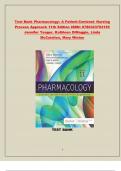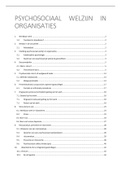Test Bank Pharmacology: A Patient-Centered Nursing
Process Approach 11th Edition ISBN: 9780323793155
Jennifer Yeager, Kathleen DiMaggio, Linda
McCuistion, Mary Winton
TEST BANK
1
, Test Bank Pharmacology: A Patient-Centered Nursing Process
Approach 11th Edition ISBN: 9780323793155 Jennifer Yeager,
Kathleen DiMaggio, Linda McCuistion, Mary Winton
Table of Content
1. Clinical Judgment Management Model (CJMM) and the Nursing Process
2. Drug Development and Ethical Considerations
3. Pharmacokinetics and Pharmacodynamics
4. Pharmacogenetics
5. Complementary and Alternative Therapies
6. Pediatric Considerations
7. Drug Therapy in Older Adults
8. Drugs in Substance Use Disorder
9. Safety and Quality
10. Drug Administration
11. Drug Calculations
12. Fluid Volume and Electrolytes
13. Vitamin and Mineral Replacement
14. Nutritional Support
15. Adrenergic Agonists and Antagonists
16. Cholinergic Agonists and Antagonists
17. Stimulants
18. Depressants
19. Antiseizure Drugs
20. Drugs for Parkinsonism and Alzheimer Disease
21. Drugs for Neuromuscular Disorders and Muscle Spasms
22. Antipsychotics and Anxiolytics
23. Antidepressants and Mood Stabilizers
24. Antiinflammatories
25. Analgesics
26. Penicillins, Other Beta-Lactams, and Cephalosporins
27. Macrolides, Oxazolidinones, Lincosamides, Glycopeptides, Ketolides, and Lipopeptides
28. Tetracyclines, Glycylcyclines, Aminoglycosides, and Fluoroquinolones
29. Sulfonamides and Nitroimidazoles Antibiotics
30. Antituberculars, Antifungals, and Antivirals
31. Antimalarials, Anthelmintics, and Peptides
32. HIV- and AIDS-Related Drugs
33. TrANSWER plant Drugs
34. Vaccines
35. Anticancer Drugs
36. Targeted Therapies to Treat Cancer
2
,37. Biologic Response Modifiers
38. Upper Respiratory Disorders
39. Low er Respiratory Disorders
40. Cardiac Glycosides, Antianginals, and Antidysrhythmics
41. Diuretics
42. Antihypertensives
43. Anticoagulants, Antiplatelets, and Thrombolytics
44. Antihyperlipidemics and Drugs to Improve Peripheral Blood Flow
45. Gastrointestinal Tract Disorders
46. Antiulcer Drugs
47. Eye and Ear Disorders
48. Dermatologic Disorders
49. Pituitary, Thyroid, Parathyroid, and Adrenal Disorders
50. Antidiabetics
51. Urinary Disorders
52. Pregnancy and Preterm Labor
53. Labor, Delivery, and Postpartum
54. Neonatal and New born
55. Women’s Reproductive Health
56. Men’s Reproductive Health
57. Sexually TrANSWER mitted Infections
58. Adult and Pediatric Emergency Drugs
3
, Chapter 01: The Nursing Process and Patient-Centered Care
McCuistion: Pharmacology: A Patient-Centered Nursing Process Approach, 11th Edition
MULTIPLE CHOICE
1. All of the follow ing w ould be considered subjective data, EXCEPT:
a. Patient-reported health history
b. Patient-reported signs and symptoms of their illness
c. Financial barriers reported by the patient’s caregiver
d. Vital signs obtained from the medical record
ANSW ER : D
Subjective data is based on w hat patients or family members communicate to the nurse. Patient- reported health history,
signs and symptoms, and caregiver reported financial barriers w ould be considered subjective data. Vital signs obtained from
the medical record w ould be considered objective data.
DIF: Cognitive Level: Understanding (Comprehension) TOP: Nursing Process: Planning MSC:
NCLEX: Management of Client Care
2. The nurse is using data collected to define a set of interventions to achieve the most desirable outcomes. Which of the
follow ing steps is the nurse applying?
a. Recognizing cues (assessment)
b. Analyze cues & prioritize hypothesis (analysis)
c. Generate solutions (planning)
d. Take action (nursing interventions)
ANSW ER : C
When generating solutions (planning), the nurse identifies expected outcomes and uses the patient’s problem(s) to define a
set of interventions to achieve the most desirable outcomes. Recognizing cues (assessment) involves the gathering of
cues (information) from the patient about their health and lifestyle practices, w hich are important facts that aid the nurse
in making clinical care decisions. Prioritizing hypothesis is used to organize and rank the patient problem(s) identified.
Finally, taking action involves implementation of nursing interventions to accomplish the expected outcomes.
DIF: Cognitive Level: Understanding (Comprehension) TOP: Nursing
Process: Nursing Intervention
MSC: NCLEX: Management of Client Care
3. A 5-year-old child w ith type 1 diabetes mellitus has had repeated hospitalizations for episodes of hyperglycemia. The
parents tell the nurse that they can’t keep track of everything that has to be done to care for their child. The nurse review s
medications, diet, and symptom management w ith the parents and draw s up a daily checklist for the family to use. These
activities are completed in w hich step of the nursing process?
a. Recognizing cues (assessment)
b. Analyze cues & prioritize hypothesis (analysis)
4





